Cool Tricks to Do on a Trampoline
This post contains affiliate links. As an Amazon Associate, we earn from qualifying purchases.
Trampolines have long been a source of amusement and physical activity for both children and adults. The allure of performing gravity-defying stunts on a bouncy surface is undeniably captivating. From basic jumps to advanced flips, there is an array of cool tricks to explore.
However, what makes trampoline tricks truly enticing is not just the spectacle, but the benefits they offer in terms of physical coordination and mental discipline. As we explore the realm of trampoline tricks, we'll uncover the intricate skill set and athleticism required to execute these maneuvers.
Key Takeaways
- Beginner trampoline tricks include tuck jumps, pike jumps, straddle jumps, half/full jumps, and seat drops to improve body control, coordination, flexibility, and landing techniques.
- Intermediate trampoline tricks involve double bounces, seat drop to feet transitions, 360-degree turns, back handsprings, and front handsprings to enhance jumping power, control, balance, rotation, and skill progression.
- Safety precautions such as using protective gear, proper supervision, avoiding overexertion, warming up, and following technique and form are essential to minimize injury risks while practicing trampoline tricks.
- Basic jumps on a trampoline like front drops, bottom bounces, jumping jacks, warm-ups, and maintaining distance from other jumpers help build foundational technique, control, rhythm, coordination, and prevent collisions.
Beginner Trampoline Tricks
Beginner trampoline tricks are essential for developing foundational skills and confidence in trampoline activities. Basic trampoline tricks like Tuck Jumps, Pike Jumps, Straddle Jumps, Half/Full Jumps, and Seat Drops provide an excellent starting point for individuals new to trampolining.
Tuck Jumps involve raising the knees to the chest while jumping and folding the body, helping beginners understand body control and coordination.
Pike Jumps, on the other hand, focus on straightening the legs parallel to the ground while folding the torso, promoting flexibility and core strength.
Straddle Jumps enhance lateral movement and agility, while Half/Full Jumps introduce the concept of directional changes and flips.
Lastly, Seat Drops encourage proper landing techniques.
Mastering these beginner trampoline tricks lays a solid groundwork for more advanced maneuvers and routines, making them crucial for aspiring trampolinists.
Intermediate Trampoline Tricks
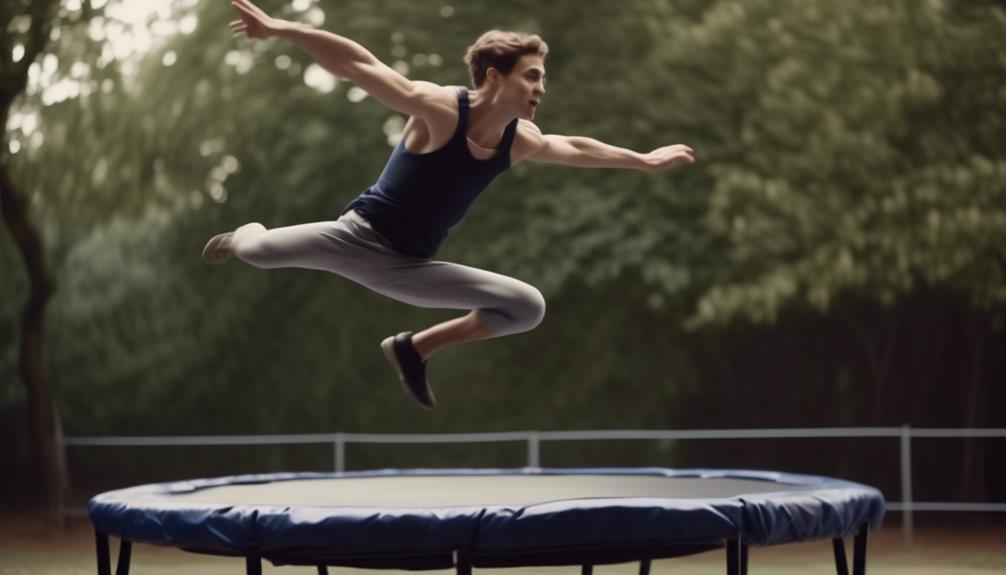
As trampoline enthusiasts progress to intermediate tricks, it becomes crucial to understand the levels of trick progression and the safety measures that need to be taken. By analyzing the different levels of trick difficulty and the precautions necessary, trampoline users can ensure a safe and successful progression in their skills.
Evidence-based guidelines for trick progression and safety precautions will be essential for those looking to advance their trampoline abilities.
Trick Progression Levels
In progressing to intermediate trampoline tricks, mastering the back handspring, front handspring, backflip, frontflip, and sideflip is essential for developing a strong foundation of skills. Once these fundamental tricks are confidently executed, advancing to more complex and impressive maneuvers becomes achievable.
These advanced tricks include:
- Double Bounce: Enhance your jumping power by mastering the coordination required to execute multiple jumps before performing a trick.
- Seat Drop to Feet: Practice transitioning from a seated position to standing on your feet, which will improve your overall control and balance on the trampoline.
- 360-degree Turns: Develop the ability to rotate smoothly in mid-air, adding a stylish element to your routine.
Safety and Precautions
After establishing a strong foundation by mastering fundamental trampoline tricks such as the back handspring, front handspring, backflip, frontflip, and sideflip, it is imperative to prioritize safety and precautions when advancing to intermediate-level maneuvers. Safety should always be the top priority when attempting any trampoline tricks, especially those of an intermediate level. This involves using protective gear such as helmets and padding, ensuring proper supervision and maintaining the trampoline in good condition. It's crucial to avoid overexertion, warm up before attempting tricks, and follow proper technique and form. The table below outlines some essential safety measures and precautions to take when practicing intermediate trampoline tricks.
| Safety Measure | Description |
|---|---|
| Use Protective Gear | Helmets and padding should always be worn to minimize the risk of injury. |
| Proper Supervision | Beginners especially need supervision, and the trampoline should be well-maintained. |
| Avoid Overexertion | Pushing beyond personal limits can lead to injuries, so it's important to know when to stop. |
Basic Jumps
When it comes to basic trampoline jumps, understanding the various bounce variations and safety tips is essential. These foundational skills form the basis for more complex maneuvers and are crucial for a safe and enjoyable trampoline experience.
Bounce Variations
Mastering the art of bounce variations in trampoline tricks requires a combination of control, precision, and fluidity in executing basic jumps. To enhance your trampoline skills, consider incorporating the following bounce variations:
- Front Drop: Start with the basics by landing on the trampoline with your feet first, mastering the foundational technique before progressing to more advanced moves.
- Bottom Bounce: Develop control and rhythm by sitting and bouncing back up, refining your ability to maintain stability and balance while executing basic jumps.
- Jumping Jack: Practice the classic jumping jack motion while bouncing to improve coordination and agility, setting the stage for more complex maneuvers like the front flip or front handspring.
Safety Tips
To ensure a safe and productive practice of basic jumps on the trampoline, it is crucial to adhere to essential safety tips, building upon the foundation of control and precision established through mastering bounce variations. The following table outlines key safety tips for basic jumps:
| Safety Tips for Basic Jumps |
|---|
| 1. Always warm up before attempting basic jumps to prevent muscle strains and injuries. |
| 2. Maintain a safe distance from other jumpers to avoid collisions and accidents. |
| 3. Use a trampoline with an enclosure to minimize the risk of falling off and getting injured. |
| 4. Always use proper landing techniques to reduce impact and prevent sprains or fractures. |
| 5. Beginners should have adult supervision when practicing basic jumps to ensure safety and proper technique. |
Advanced Flips
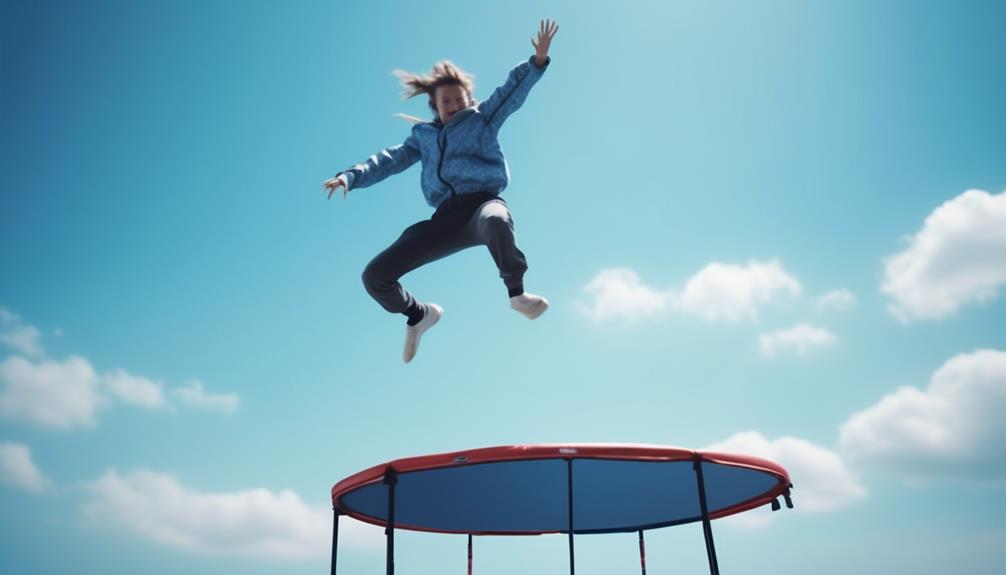
Advanced flips on a trampoline require precise control, technique, and athleticism to execute safely and effectively. When attempting advanced flips, it's crucial to focus on mastering the fundamental techniques while gradually progressing to more complex maneuvers.
Here are some advanced flips to consider:
- Backflip: Gain height by jumping and tucking, rotate backward, and land on both feet.
- Barani Flip: Execute a front somersault with a half twist before landing on the trampoline.
- Corkscrew: Gain height, rotate around the longitudinal axis, and land with both feet.
These advanced flips demand a strong understanding of body positioning, spatial awareness, and timing. It's essential to practice these maneuvers under the guidance of a trained instructor and to use proper safety equipment to minimize the risk of injury.
Bouncing Techniques
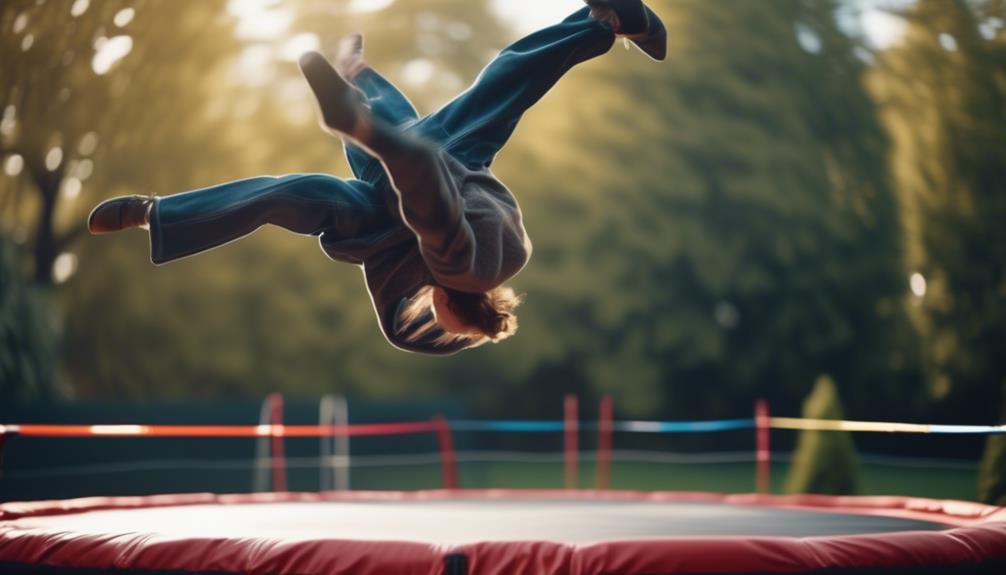
Developing a strong foundation in bouncing techniques is essential for mastering advanced flips on a trampoline.
The straight bounce involves keeping your legs together and bouncing evenly on the trampoline surface.
Practice the seat drop by jumping straight up and landing seated with your legs straightened out in front of you.
To master the pike jump technique, jump and straighten your legs parallel to the ground with your torso folded.
The tuck jump involves raising your knees to your chest while jumping and folding your body.
Lastly, learn the straddle jump by keeping your legs together while jumping side to side or front to back.
These techniques form the basis for more advanced moves and can help improve control and height on the trampoline.
Safety Tips
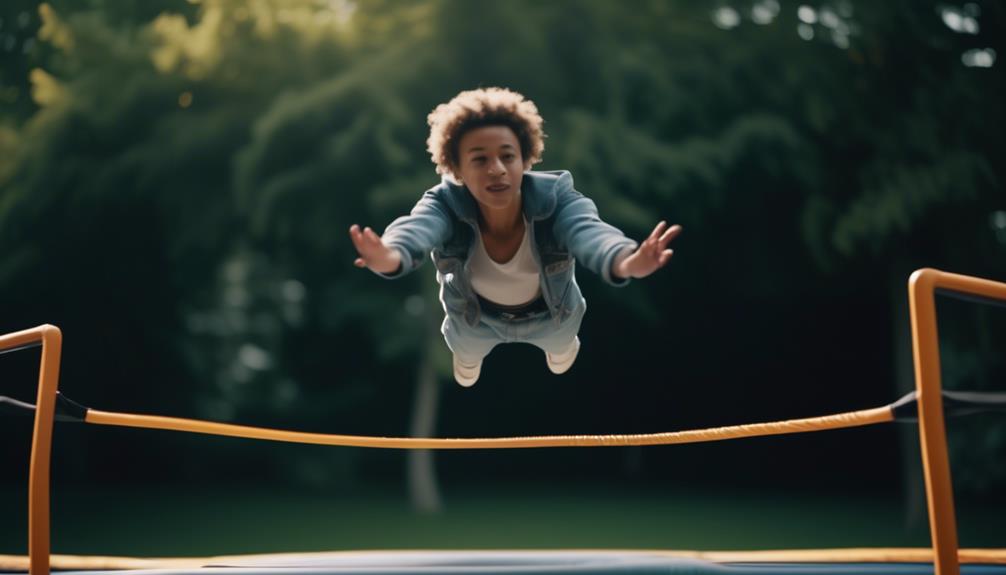
Practicing trampoline safety is essential for preventing accidents and injuries during trick attempts. To ensure a safe trampoline experience, follow these important safety tips:
- Use Protective Gear: Always wear helmets and padding to minimize the risk of injury, especially when attempting advanced tricks like the front drop.
- Learn Correct Form: Proper technique is crucial for safe trick execution. Practice landing on your knees to reduce impact and minimize the risk of injury.
- Supervision and Maintenance: Beginners should have adult supervision, and trampolines should be regularly checked for any damage or wear to ensure safe usage.
Alternate Landings
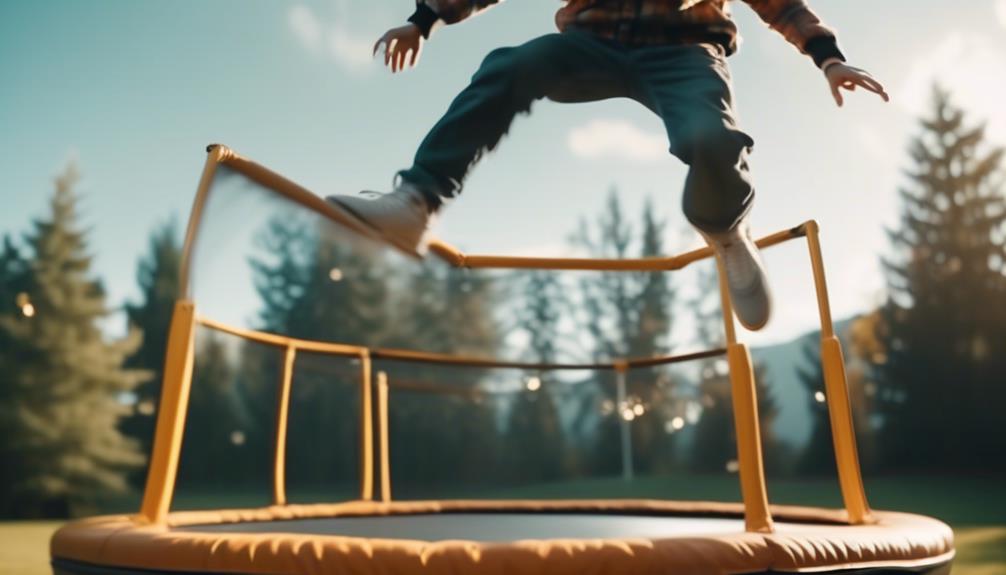
To further cultivate a safe and skillful trampoline practice, mastering alternate landings is crucial for expanding your repertoire of tricks and enhancing overall balance and control.
Experiment with the half twist to add flair and challenge to your routine, allowing you to land facing a different direction than your takeoff.
Additionally, practicing landing on your back can enhance your spatial awareness and proprioception, key components of trampoline safety and skill development.
Split landings provide an opportunity to showcase agility and flexibility, while seat landings and knee landings add variety and creativity to your repertoire.
Lastly, incorporating side landings can elevate the complexity of your routine, requiring precise body positioning and control.
Expert Q&A

Engaging in trampoline activities requires a keen understanding of safety protocols, proper technique, and skill development. To provide valuable insights into mastering trampoline tricks, we've gathered expert responses to common questions:
- How can I impress my friends with trampoline tricks?
- Start with basic tricks like the seat drop and progress to more advanced moves like the front flip or the 360-degree spin.
- Emphasize smooth and controlled movements to showcase your skills effectively.
- What are some safety tips for attempting advanced tricks?
- Always warm up before attempting advanced tricks to prevent muscle strains.
- Ensure that the trampoline is in good condition, with no tears or worn-out springs.
- Practice new tricks under supervision until you have mastered them.
- How can I continue to improve my trampoline skills?
- Consistent practice and dedication are crucial.
- Consider taking trampoline classes or seeking guidance from experienced trampolinists to refine your techniques and broaden your skill set.
Frequently Asked Questions
How to Do a Cool Flip on a Trampoline?
To execute a cool flip on a trampoline, gain height through a powerful jump and arm movement, then rotate the body forward for a front flip, ensuring a safe landing on both feet. Emphasize gradual progression and proper technique for successful execution.
How Can I Make My Trampoline More Fun?
To make your trampoline more enjoyable, incorporate interactive games and explore various tricks to challenge yourself. Ensure safety measures are in place and consider joining a trampoline club for structured training and skill development.
What Moves Can You Do on a Trampoline?
There are various moves you can perform on a trampoline, such as the seat drop, front drop, back drop, and knee drop. Additionally, you can execute more advanced moves like the front somersault and back somersault with proper technique and practice.
What Should I Do on a Trampoline?
When utilizing a trampoline, individuals should engage in a variety of jumps, flips, and other maneuvers to enhance their skill and coordination. It is important to prioritize safety and gradual progression when attempting new techniques.
Conclusion
In conclusion, trampoline tricks offer a fun and engaging way to enhance physical fitness and coordination skills. From basic jumps to advanced flips, there are a variety of tricks that can be attempted based on skill level.
It is important to prioritize safety by using protective gear and proper technique, and to gradually progress to more advanced tricks.
Trampoline tricks not only provide entertainment but also contribute to overall physical and mental well-being.
